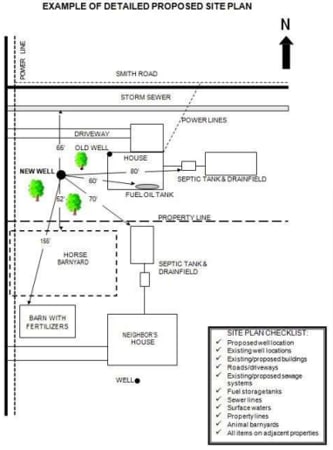Many states in the US have set a minimum horizontal distance of 50 feet from a private water well. Some areas have a 100-feet requirement due to highly permeable soil. Moreover, some states want you to ensure that the water well is not located down-gradient of the septic tank.
The minimum distance in Colorado is around 200 feet. However, variance can be issued based on the geologist’s assessment. Alaska requires a septic tank to be at least 100 feet away from the well casing. Ohio has set a minimum distance of 150 feet.
Some states may want you to increase the minimum distance between the septic tank and a well from 50 to 100 feet if the proposed well utilizes an unconfined aquifer.
The distance also varies based on soil quality in the area and the slope of the land. Some states require you to maintain a distance of 50 feet or more from your neighbor’s well or septic tank.
So, it is best to check local laws before building a water well at your property or installing a septic tank. Local authorities can stop you from using well water if legal requirements are not fulfilled.
However, this rarely happens as only certified well contractors can drill a well on your property. They are fully aware of local laws. The contractors don’t take any risks because their reputation is at stake.

Image Credits: Department of Environment, Great Lakes and Energy, Michigan
Risks and Benefits
Risks
The biggest risk is water contamination if the septic tank is located near your well. This doesn’t normally happen if the septic tank and drains don’t have any leaks.
Leaks in the septic tank or drains can happen anytime, and the contamination risk will be higher if the soil is fully permeable, the well casing is damaged, or your well doesn’t sit too deep.
The contaminants in a septic tank are bacteria (E.coli), viruses, phosphatases, nitrates, chemicals, and heavy metals. These contaminants can cause various health conditions like diarrhea, nausea, headache, body pain, and even worst effects in kids.
Please get your well water tested immediately if you feel it has been exposed to septic tank contents.
Benefits
You get to enjoy natural quality water without contamination from your well. Well water is better than city water because it is rich in healthy minerals but is often treated due to pollutants and sediment.
A properly located and working septic tank will ensure your home’s hygiene. Hence, following all the laws while constructing a well at your property is important.
Can I deviate from the minimum setback distance between the septic tank and well water?
The local health department can allow variation in rare cases. You must request any change in writing before starting well construction.
What is the minimum distance from various contamination sources?
The minimum distance depends on the nature of the contamination source. Here’s a list of minimum distances that need to be maintained in 13 major US states.
Can a septic tank and well water be on the same side of the house?
Yes. Septic tank and water well can be on the same side of the house, but they have to be horizontally apart from each other by a fixed distance. Each state has different laws about well construction. It is best to consult the local health office for updated laws.
